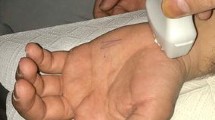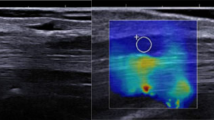Abstract
Objectives
To correlate the cross-sectional area (CSA) and elasticity of the median nerve (MN) measured at carpal tunnel inlet between healthy controls and various degrees of carpal tunnel syndrome (CTS) graded as per nerve conduction studies (NCS).
Materials and methods
A total of 53 patients (with 81 wrists) presenting with clinical symptoms characteristic of CTS, having their diagnosis confirmed and severity graded by NCS, and 48 healthy controls (with 96 wrists) were included in the study. All the study participants underwent wrist ultrasound which included initial Grey-scale USG followed by strain and shear wave elastography. The CSA and elasticity (in terms of strain ratio and shear modulus) of MN were measured at the carpal tunnel inlet. Statistical analysis was performed using the Mann–Whitney U test to compare between the two groups and for subgroup analysis of cases. The diagnostic performance of each variable was evaluated using the receiver operating characteristic curves.
Results
The mean CSA was 9.20 ± 1.64, 11.48 ± 1.05, 14.83 ± 1.19 and 19.87 ± 2.68 mm2, the mean shear modulus was 17.93 ± 2.81, 23.59 ± 2.63, 32.99 ± 4.14 and 54.26 ± 9.24 kPa and the mean strain ratio was 5.26 ± 0.68, 5.56 ± 0.70, 7.03 ± 0.47 and 8.81 ± 0.94 in control, mild, moderate and severe grades of CTS, respectively (p < 0.001).
Conclusion
The combined utility of Grey-scale USG and Elastography may serve as a painless and cost-effective alternative to NCS in grading the severity of CTS.







Similar content being viewed by others
References
Peterson JJ, Berquist TH. Hand and Wrist. In: Peterson JJ, editor. Berquist’s Musculoskeletal Imaging Companion. 3rd ed. Philadelphia: Wolters Kluwer; 2018. p. 826–7.
De Krom MC, Knipschild PG, Kester AD, Thijs CT, Boekkooi PF, Spaans F. Carpal tunnel syndrome: prevalence in the general population. J Clin Epidemiol. 1992;45(4):373–6.
Witt JC, Hentz JG, Stevens JC. Carpal tunnel syndrome with normal nerve conduction studies. Muscle Nerve. 2004;29(4):515–22.
Wong SM, Griffith JF, Hui AC, Tang A, Wong KS. Discriminatory sonographic criteria for the diagnosis of carpal tunnel syndrome. Arthritis Rheum. 2002;46(7):1914–21.
Mallouhi A, Pültzl P, Trieb T, Piza H, Bodner G. Predictors of carpal tunnel syndrome: accuracy of gray-scale and color Doppler sonography. Am J Roentgenol. 2006;186(5):1240–5.
Pinilla I, Martin-Hervas C, Sordo G, Santiago S. The usefulness of ultrasonography in the diagnosis of carpal tunnel syndrome. J Hand Surg Eur. 2008;33(4):435–9.
Klauser AS, Halpern EJ, De Zordo T, Feuchtner GM, Arora R, Gruber J, et al. Carpal tunnel syndrome assessment with US: value of additional cross-sectional area measurements of the median nerve in patients versus healthy volunteers. Radiology. 2009;250(1):171–7.
Moran L, Perez M, Esteban A, Bellon J, Arranz B, del Cerro M. Sonographic measurement of cross-sectional area of the median nerve in the diagnosis of carpal tunnel syndrome: correlation with nerve conduction studies. J Clin Ultrasound. 2009;37(3):125–31.
Kang S, Kwon HK, Kim KH, Yun HS. Ultrasonography of median nerve and electrophysiologic severity in carpal tunnel syndrome. Ann Rehabil Med. 2012;36(1):72–9.
Azami A, Maleki N, Anari H, Iranparvar Alamdari M, Kalantarhormozi M, Tavosi Z. The diagnostic value of ultrasound compared with nerve conduction velocity in carpal tunnel syndrome. Int J Rheum Dis. 2014;17(6):612–20.
Mourad MA, Kareem HA. Idiopathic carpal tunnel syndrome (ICTS): correlation between nerve conduction studies and dynamic wrist ultrasonography. Egypt J Radiol Nucl Med. 2018;49(4):1060–7.
Pimentel BF, Faloppa F, Tamaoki MJ, Belloti JC. Effectiveness of ultrasonography and nerve conduction studies in the diagnosing of carpal tunnel syndrome: clinical trial on accuracy. BMC Musculoskelet Disord. 2018;19(1):115.
Falsetti P, Conticini E, Baldi C, D’Ignazio E, Al Khayyat SG, Bardelli M, et al. A novel ultrasonographic anthropometric-independent measurement of median nerve swelling in carpal tunnel syndrome: the “nerve/tendon ratio” (NTR). Diagnostics. 2022;12(11):2621.
Zaki HA, Shaban E, Salem W, Bilal F, Fayed M, Hendy M, et al. A comparative analysis between ultrasound and electromyographic and nerve conduction studies in diagnosing carpal tunnel syndrome (CTS): a systematic review and meta-analysis. Cureus. 2022;14(10):e30476.
Tai T-W, Wu C-Y, Su F-C, Chern T-C, Jou I-M. Ultrasonography for diagnosing carpal tunnel syndrome: a meta-analysis of diagnostic test accuracy. Ultrasound Med Biol. 2012;38:1121–8.
Gennisson JL, Deffieux T, Fink M, Tanter M. Ultrasound elastography: principles and techniques. Diagn Interv Imaging. 2013;94(5):487–95.
Jablecki CK, Andary MT, Floeter MK, Miller RG, Quartly CA, Vennix MJ, et al. Practice parameter: electrodiagnostic studies in carpal tunnel syndrome. Neurology. 2002;58(11):1589–92.
Stevens JC. AAEM minimonograph #26: the electrodiagnosis of carpal tunnel syndrome. American Association of Electrodiagnostic Medicine. Muscle Nerve. 1997;20(12):1477–86.
Miyamoto H, Halpern EJ, Kastlunger M, Gabl M, Arora R, Bellmann -Weiler R, et al. Carpal tunnel syndrome: diagnosis by means of median nerve elasticity—improved diagnostic accuracy of US with sonoelastography. Radiology. 2014;270(2):481–6.
Yoshii Y, Ishii T, Tanaka T, Tung WL, Sakai S. Detecting median nerve strain changes with cyclic compression apparatus: a comparison of carpal tunnel syndrome patients and healthy controls. Ultrasound Med Biol. 2015;41(3):669–74.
Asadov R, Erdal A, Buğdaycı O, Gündüz OH, Ekinci G. The effectiveness of ultrasonography and ultrasonographic elastography in the diagnosis of carpal tunnel syndrome and evaluation of treatment response after steroid injection. Eur J Radiol. 2018;108:172–6.
Kantarci F, Ustabasioglu FE, Delil S, Olgun DC, Korkmazer B, Dikici AS, et al. Median nerve stiffness measurement by shear wave elastography: a potential sonographic method in the diagnosis of carpal tunnel syndrome. Eur Radiol. 2014;24(2):434–40.
Cingoz M, Kandemirli SG, Alis DC, Samanci C, Kandemirli GC, Adatepe NU. Evaluation of median nerve by shear wave elastography and diffusion tensor imaging in carpal tunnel syndrome. Eur J Radiol. 2018;101:59–64.
Park EJ, Hahn S, Yi J, Shin KJ, Lee Y, Lee HJ. Comparison of the diagnostic performance of strain elastography and shear wave elastography for the diagnosis of carpal tunnel syndrome. J Med Ultrason. 2021;40(5):1011–21.
Author information
Authors and Affiliations
Corresponding author
Ethics declarations
Conflict of interest
The authors declare no competing interests.
Additional information
Publisher's Note
Springer Nature remains neutral with regard to jurisdictional claims in published maps and institutional affiliations.
Supplementary Information
Below is the link to the electronic supplementary material.
Rights and permissions
Springer Nature or its licensor (e.g. a society or other partner) holds exclusive rights to this article under a publishing agreement with the author(s) or other rightsholder(s); author self-archiving of the accepted manuscript version of this article is solely governed by the terms of such publishing agreement and applicable law.
About this article
Cite this article
Prakash, A., Vinutha, H., Janardhan, D.C. et al. Diagnostic efficacy of high-frequency Grey-scale ultrasonography and Sono-elastography in grading the severity of carpal tunnel syndrome in comparison to nerve conduction studies. Skeletal Radiol (2024). https://doi.org/10.1007/s00256-024-04662-y
Received:
Revised:
Accepted:
Published:
DOI: https://doi.org/10.1007/s00256-024-04662-y




